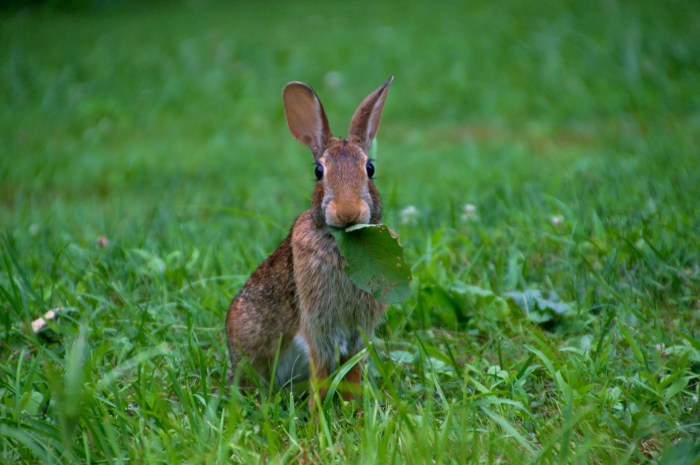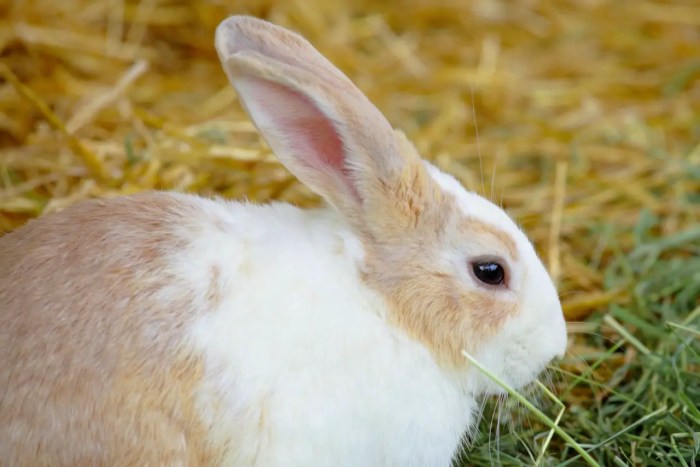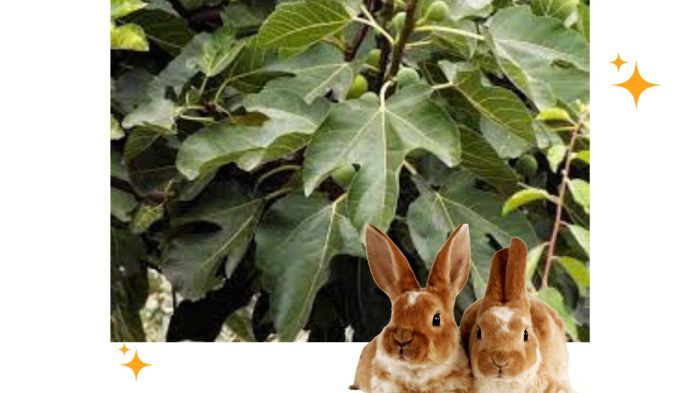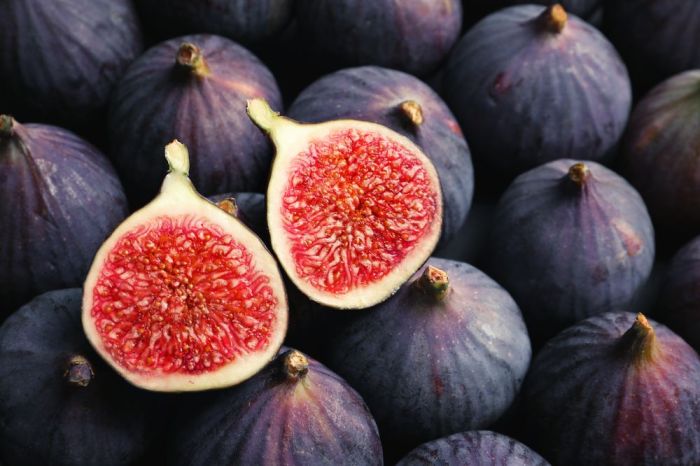As the question of can rabbits eat fig leaves takes center stage, this opening passage beckons readers into a world crafted with expertise and a casual yet formal tone, ensuring a reading experience that is both absorbing and distinctly original.
Delving into the topic, we will explore the nutritional value of fig leaves, their potential health benefits for rabbits, and the proper way to introduce them into a rabbit’s diet. We will also discuss any precautions and considerations to keep in mind, as well as offer alternatives to fig leaves for those seeking variety.
Nutritional Value of Fig Leaves: Can Rabbits Eat Fig Leaves

Fig leaves are a rich source of various nutrients, including vitamins, minerals, and antioxidants. They are a good source of dietary fiber, vitamin A, vitamin C, and potassium. Fig leaves also contain significant amounts of calcium, iron, magnesium, and phosphorus.
Vitamins
Fig leaves are a good source of several vitamins, including:
- Vitamin A:Vitamin A is important for vision, immune function, and skin health.
- Vitamin C:Vitamin C is a powerful antioxidant that helps protect cells from damage.
- Vitamin K:Vitamin K is essential for blood clotting and bone health.
Minerals, Can rabbits eat fig leaves
Fig leaves are also a good source of several minerals, including:
- Potassium:Potassium is an important mineral for maintaining fluid balance in the body.
- Calcium:Calcium is essential for strong bones and teeth.
- Iron:Iron is necessary for the production of red blood cells.
- Magnesium:Magnesium is involved in over 300 enzymatic reactions in the body.
- Phosphorus:Phosphorus is essential for bone health and energy production.
Antioxidants
Fig leaves are a good source of antioxidants, which help protect cells from damage caused by free radicals. Free radicals are unstable molecules that can damage cells and contribute to aging and disease. The antioxidants in fig leaves include:
- Quercetin:Quercetin is a flavonoid antioxidant that has been shown to have anti-inflammatory and anti-cancer properties.
- Kaempferol:Kaempferol is another flavonoid antioxidant that has been shown to have anti-inflammatory and anti-cancer properties.
- Chlorogenic acid:Chlorogenic acid is a polyphenol antioxidant that has been shown to have anti-inflammatory and anti-diabetic properties.
Health Benefits of Fig Leaves for Rabbits

Fig leaves offer numerous health benefits for rabbits, contributing to their overall well-being.
Digestive Support
Fig leaves contain enzymes that aid in the breakdown of food, promoting efficient digestion. The high fiber content in fig leaves also helps regulate bowel movements, preventing constipation and diarrhea.
Anti-inflammatory Properties
Fig leaves possess anti-inflammatory compounds that help reduce inflammation throughout the body. This can alleviate discomfort and pain caused by various conditions, such as arthritis or digestive issues.
Immune System Boost
Fig leaves are rich in antioxidants and vitamins, which help strengthen the immune system and protect rabbits from infections and diseases. The high vitamin C content in fig leaves is particularly beneficial for immune function.
How to Feed Fig Leaves to Rabbits

Introducing fig leaves into a rabbit’s diet requires a gradual approach to prevent digestive upset. Start by offering a small amount, about a leaf or two, once or twice a week.
While rabbits can munch on fig leaves, it’s worth noting that their nutritional value is debatable. A study like the Mier y Teran Report sheds light on the complexities of rabbit diets, emphasizing the importance of consulting with a veterinarian before making significant changes to your furry friend’s menu.
So, can rabbits eat fig leaves? Yes, but proceed with caution and seek professional guidance to ensure your rabbit’s well-being.
As your rabbit tolerates the fig leaves, you can gradually increase the frequency and amount offered. Aim to provide no more than 10-15% of their daily diet as fig leaves, as excessive consumption can lead to diarrhea.
Fresh Fig Leaves
- Rinse fresh fig leaves thoroughly before offering them to your rabbit.
- Remove any wilted or damaged leaves.
- Cut the leaves into small pieces to make them easier for your rabbit to eat.
Dried Fig Leaves
- Dried fig leaves can be offered as a treat or supplement to fresh leaves.
- Crush the dried leaves into small pieces before giving them to your rabbit.
- Limit the amount of dried fig leaves offered, as they are more concentrated than fresh leaves.
Precautions and Considerations

While fig leaves are generally safe for rabbits, it’s important to exercise caution and consider the following precautions and considerations:
Potential Risks and Contraindications
- Gastrointestinal Issues:Consuming excessive amounts of fig leaves can lead to digestive upset, including diarrhea and bloat. Start with small amounts and gradually increase the quantity to allow their digestive systems to adapt.
- Kidney Problems:Fig leaves contain oxalates, which can contribute to the formation of kidney stones in some rabbits. Avoid feeding fig leaves to rabbits with a history of kidney issues.
- Respiratory Issues:The sap from fig leaves can irritate the respiratory system of some rabbits, causing coughing and sneezing. Monitor your rabbit closely when introducing fig leaves to their diet.
Alternatives to Fig Leaves
Fig leaves offer nutritional benefits for rabbits, but there are also other leafy greens that can provide similar nutrients. These alternatives are widely available and can be incorporated into your rabbit’s diet to ensure a balanced and varied intake.
Nutritional Comparison
The table below compares the nutritional value of fig leaves to other leafy greens commonly fed to rabbits:| Leafy Green | Calories | Protein | Fiber | Calcium ||—|—|—|—|—|| Fig Leaves | 56 | 3.2g | 5.1g | 160mg || Romaine Lettuce | 17 | 1.2g
| 1.6g | 50mg || Spinach | 7 | 0.9g | 0.4g | 29mg || Kale | 33 | 3.0g | 2.6g
| 100mg || Dandelion Greens | 25 | 1.7g | 1.5g | 80mg |As you can see, fig leaves are a good source of calories, protein, fiber, and calcium compared to other leafy greens. However, it is important to note that the nutritional value of leafy greens can vary depending on the growing conditions and harvesting time.
Q&A
How often can I feed fig leaves to my rabbit?
Fig leaves should be offered sparingly, no more than once or twice a week.
Can baby rabbits eat fig leaves?
No, baby rabbits under 12 weeks old should not be given fig leaves.
What are some alternatives to fig leaves for rabbits?
Suitable alternatives include dandelion greens, romaine lettuce, and arugula.